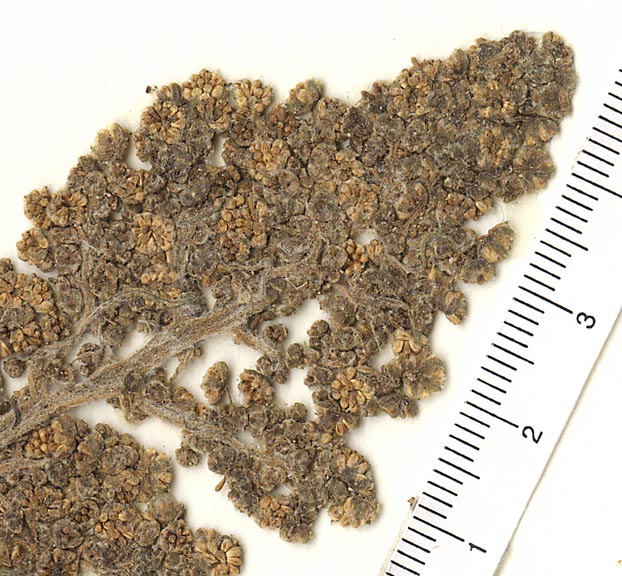
|
Family: Asteraceae |
Annuals, perennials, subshrubs, or shrubs, 10-350 cm. Stems usually erect, sometimes decumbent to sprawling, often freely branched. Leaves cauline; mostly opposite (distal sometimes alternate); petiolate or sessile; blades (1- or 3-nerved) deltate, elliptic, filiform, lanceolate, linear, obovate, ovate, spatulate, or trullate, margins entire or toothed, faces glabrous or ± scabrellous, often gland-dotted. Heads discoid or ± disciform, in (± bracteate) racemiform or spiciform arrays (heads 1-2 in axil of each bract, bracts sometimes leaflike). Involucres ± hemispheric or turbinate to campanulate or urceolate, 2-10+ mm diam. Phyllaries persistent, 3-15+ in 1-3+ series, distinct or ± connate, all ± herbaceous or inner scarious to membranous. Receptacles flat or convex to hemispheric; paleae cuneiform or spatulate to linear or setiform, ± membranous, sometimes all or partially wanting. Pistillate florets usually 1-8+, rarely 0; corollas whitish (inconspicuous), ± tubular. Functionally staminate florets 3-20+; corollas whitish to pinkish, funnelform, lobes 5, soon reflexed (filaments ± connate, anthers coherent or distinct). Cypselae plumply obovoid to pyriform, often ± obcompressed, sometimes scabrellous or hispidulous distally, usually ± gland-dotted; pappi 0. x = 18. M. Bolick (1983), P. O. Karis (1995), and B. Miao et al. (1995, 1995b, 1995c) considered Iva in the sense of R. C. Jackson (1960) to include species that have closer relatives outside Iva in the broad sense than within. I agree and treat the extradited species in Chorisiva, Cyclachaena, Hedosyne, Leuciva, and Oxytenia. Ivas are wind pollinated, are related to the ragweeds (Ambrosia spp.), and may be similarly associated with pollen allergies. Records of Iva asperifolia Lessing from Florida are evidently based on specimens that are treated as members of I. angustifolia.
Heads disciform, the pistillate fls few, with tubular or obsolete cor; invol of a few equal or imbricate, ±herbaceous bracts in 1-3 series; receptacle small, chaffy, its bracts commonly linear or spatulate, often subtending the pistillate as well as the staminate fls, these outer pales sometimes larger and more like the bracts of the invol; disk fls 6-20 in our spp., staminate, with undivided style, connate filaments, scarcely united anthers, and abortive or no ovary; achenes obovate, thick but somewhat compressed parallel to the invol bracts; pappus none; herbs or shrubs with opposite (or the upper alternate) lvs and small heads of greenish-white fls sessile or short pedunculate in the axils of the upper lvs or bracts (infl bractless in one sp.). 15, N. Amer. Gleason, Henry A. & Cronquist, Arthur J. 1991. Manual of vascular plants of northeastern United States and adjacent Canada. lxxv + 910 pp. ©The New York Botanical Garden. All rights reserved. Used by permission. |
This project was made possible in part by the Institute of Museum and Library Services [MG-70-19-0057-19].
Powered by Symbiota



